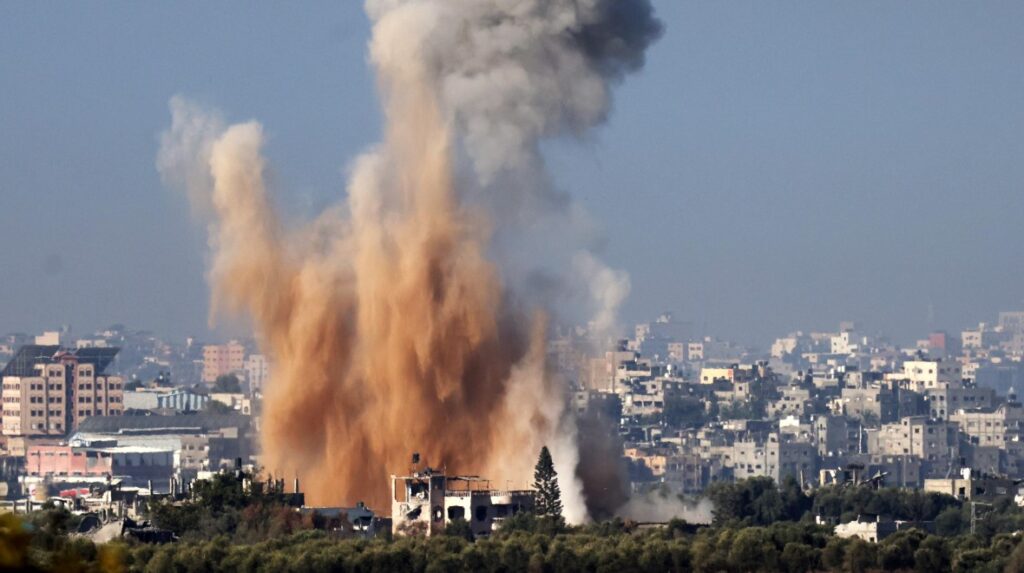
Inside war-torn Gaza in Palestine
Despite ceasefire efforts, Israel races against time, gradually occupies Gaza
Even as international mediation intensifies in pursuit of a ceasefire in Gaza, Israeli forces continue to escalate their offensive on the ground.
The paradox is striking: while diplomats draft proposals in Cairo and Doha, Gaza City’s neighbourhoods, Zeitoun, Sabra, and the city centre, are collapsing under artillery fire and airstrikes.
Speaking to The New Arab, local residents in the territory said that the Israeli tanks advance slowly but steadily, turning displacement into a daily ritual for thousands of families.
In Zeitoun, the bombardment has been relentless. Gaza’s Civil Defence reported that around 450 residential buildings were destroyed in the neighbourhood within just nine days.
Rescue workers, operating without heavy machinery and under constant shelling, describe the task as impossible.
“We hear voices under the rubble but cannot reach them. Our tools are too basic, and the destruction too massive,” Mahmoud Basal, the spokesman of the civil defence, said in a press statement.
Families are repeatedly forced to abandon their homes. Mohammed Tafish, a father of five from al-Zeitoun neighbourhood, described leaving for the third time in less than two weeks:
“The bombardment doesn’t stop, and the tanks are slowly approaching. Every day, we feel the occupation advancing a few meters while we retreat, losing our homes and our lives,” he told TNA, expressing her fears that the gradual advance could turn into full occupation of the city.
The scene in Sabra is no different. Families rush to leave in the middle of the night, carrying only what they can, such as bread, water, or children’s clothes, amid explosions and collapsing buildings.
Umm Mohammed, a grandmother in her sixties, told TNA that “I can no longer distinguish between my house and the road; everything has been reduced to rubble. All I want is a safe place for my children and grandchildren, but there is no such place in Gaza today.”
Even the centre of Gaza City, once seen as a refuge, is now under fire. Abu Hassan, a teacher from Gaza, told TNA that “we move from one neighbourhood to another, hoping to find safety. But in truth, the entire city is under attack. There is nowhere left to go.”
Israeli media outlets reported on the new military strategies. On Sunday, Hebrew outlets revealed that Chief of Staff Eyal Zamir approved an operational plan to gradually occupy Gaza City.
Defence Minister Yisrael Katz is expected to review it before the cabinet delivers final approval, according to the Israeli media outlets.
According to the Israeli Broadcasting Authority, the plan includes a two-week forced evacuation, followed by phased entry of ground troops.
Israeli Channel 12 claimed that the government is likely to endorse the plan by the end of the week.
Earlier this month, Prime Minister Benjamin Netanyahu’s security cabinet had already approved a broader proposal to reoccupy the Strip, beginning with Gaza City.
The involvement of Nitzan Alon, the Israeli coordinator on prisoners and hostages, underscores how military planning and negotiations are intertwined.
American officials have also requested details of the evacuation plan, reflecting close coordination between Washington and Tel Aviv, according to the Israeli media outlets.
Ahed Ferwana, a Gaza-based political analyst, warned that Israel is exploiting the timing.
“Israel wants to capitalise on this sensitive period before any agreement is announced to impose new facts on the ground. Every tank movement into the city represents leverage at the negotiating table,” he told TNA.
“If the war stops tomorrow, Israel will say it is physically present inside Gaza’s neighbourhoods. This gives it a stronger position to impose its terms in any future settlement,” he said.
For Palestinians, each meter of advance is both a military incursion and a political calculation.
Despite the military escalation, Hamas announced on Monday evening that it had accepted the latest ceasefire proposal from Egypt and Qatar.
In a press statement, the movement confirmed that the delegation delivered an official response after internal consultations with other Palestinian factions.
Cairo and Doha are now expected to coordinate with US envoy Steve Witkoff to move talks forward.
Palestinian sources familiar with the proposal revealed key elements: redeployment adjustments in northern and eastern Gaza, though Israel refuses to withdraw from certain zones; a prisoner swap involving the release of ten Israeli captives in exchange for 1700 Palestinian prisoners, including 1500 Gazans who were arrested during the war, those serving life sentences; and the release of women and children held in Israeli prisons.
The deal also includes the exchange of bodies, with ten Palestinians returned for every Israeli killed.
On the humanitarian level, the agreement calls for urgent entry of aid, including fuel, water, and electricity, as well as medical supplies to rehabilitate hospitals and bakeries.
International agencies such as the UN and Red Crescent would oversee distribution. Civil Defence teams would receive machinery to help extract victims from the rubble.
For civilians in Gaza, however, the negotiations evoke both hope and despair. On the one hand, there is a possibility of respite after months of war. On the other hand, Israeli tanks are already pressing into their neighbourhoods, threatening to reshape the city before the ceasefire takes effect.
